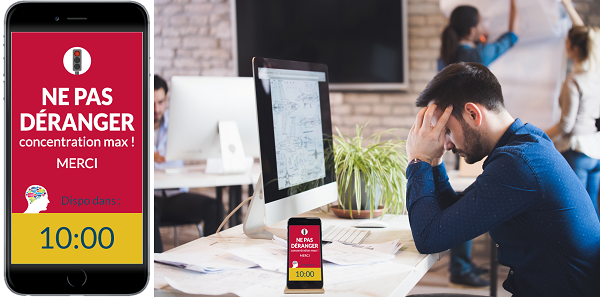
20 Feb How to focus at work in open space… thanks to our social cues!
How do you filter out your colleague’s loud phone conversations? How do you put up with an impromptu two-minute meeting that has lasted over 30? How do you tune out the sound of your office mate’s constant smartphone notifications or email alerts? Finally, how do you explain to someone that they are truly disturbing you by interrupting you every five minutes with questions…?
In other words, how do you handle the many interactions inherent to the modern work world, where collaboration and cooperation are amplified by tools, spaces, project modes, and company work modes… that are all collaborative?
In short, how do you focus in a fast-paced world that is often more stimulating than the task you wish to accomplish?
Scheduling focus periods is probably the best way to guarantee your intellectual efficiency.
When we’re working, we frequently need to mentally process information in order to think, plan, write, crosscheck, etc. To do so, your brain uses its working memory, which is only able to handle limited amounts of information (4 to 5 items, in general). If this information is directly linked to our current task, we will, then, be able to reason in an efficient, comfortable manner. If, on the contrary, our environment is overly stimulating and forces our brains to deal with information “static,” the mental space allotted to thought processes is restricted… which slows us down and increases the risk of errors.
Here are a few suggestions to improve your focus:
- 1.First, on an individual level, become aware of the true impact these many interruptions have on our intellectual comfort and on our cognitive performance. When you are interrupted, it takes you 30% longer to accomplish your task. Learn the effect of interruptions in the following video: The negative effect interruptions have on your brain.
- 2. On a group level, then, set up clear, shared rules for handling the flow of information. My Mental Energy Pro can help you to co-construct a charter for mental ecology, in order to set up individual and collective guidelines to rethink the balance between focus periods and collaboration period.
Finally, by using tools like our “Do Not Disturb” signs, which you will find inside the My Mental Energy Pro application.
- 3. These notices include timers. Once the timer is set, and the notice is visible on your smartphone, you need only to display it prominently on your desk to tell that colleague, who comes in to ask you that umpteenth question, that you are unavailable and in deep focus mode for another “X” minutes. Obviously, this will not stop someone from asking you any questions they deem extremely urgent!
These notices will allow you to avoid being interrupted and can also be used in conjunction with concentration music or white noise, which will effectively insulate you from surrounding auditory distractions. Without any interfering noises or interruptions, the only thing left to do is head straight for your goal!
Reminder:
Do not forget that your brain cannot concentrate for hours on end. It will, in fact, clearly show you when it has reached its limit, where you will find yourself distracted by the slightest outside trigger, like a ticking clock or the tapping of your office mate’s fingers upon their keyboard.
So, to preserve your mental efficiency, give your brain regular attentional mini-breaks, and know how to shift to less demanding tasks, when the need arises.
At My Mental Energy Pro, we believe that, at work, a focus period can last 25 minutes. Beyond that limit, perhaps you should let yourself get pulled into a collaborative task and/or take a refreshing mini-break.
Article written by Gael Allain and Charlotte Toso, respectively scientific director and cognitive science engineer of My Mental Energy Pro.





Désolé, les commentaires sont fermés pour le moment.